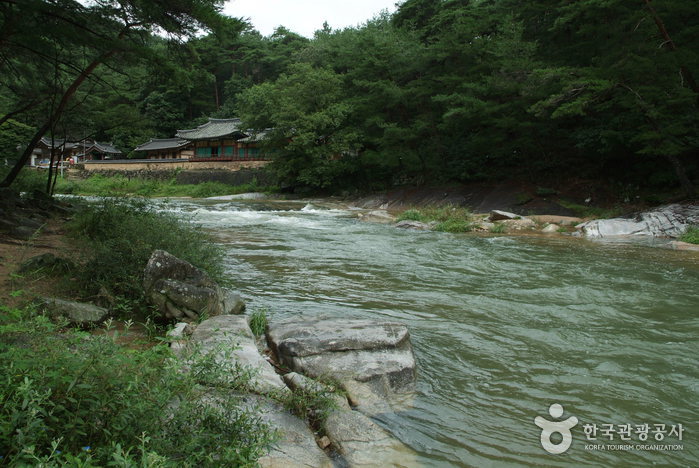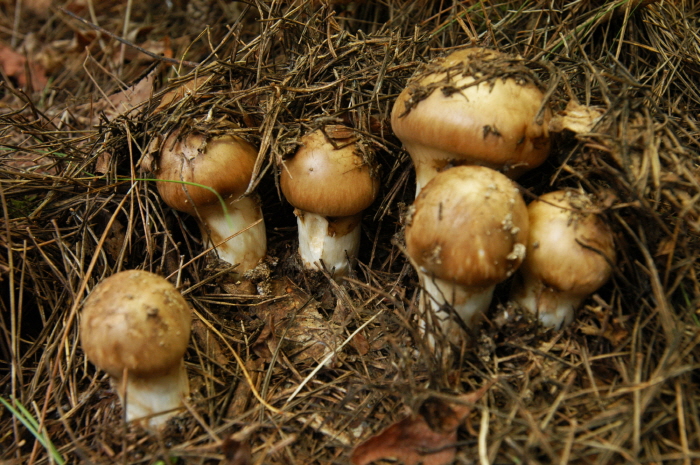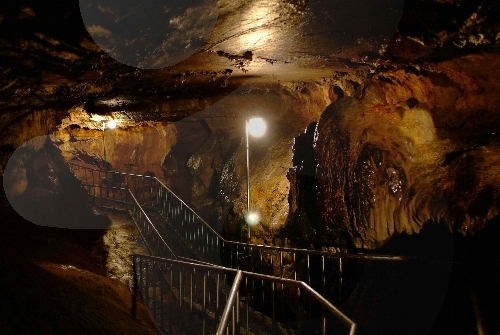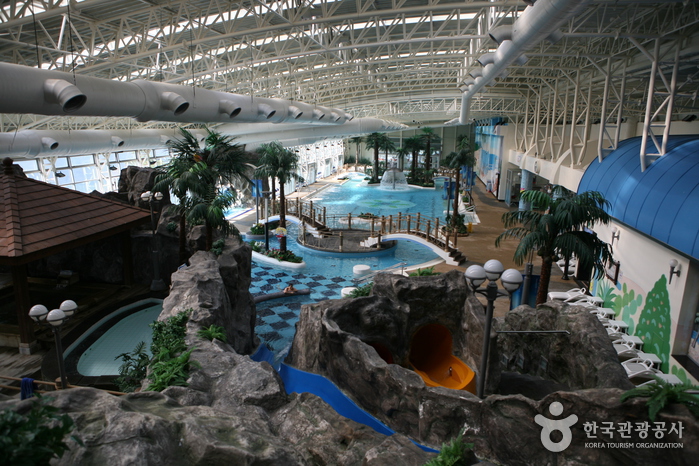Tohyang traditional house [Korea Quality] / 토향고택 [한국관광 품질인증]
14.8Km 2020-09-10
43, Baraemi 1-gil Bonghwa-eup, Bonghwa-gun, Gyeongsangbuk-do
+82-10-8575-9036
This historic house has been the home of the descendants of Kim Yeo-byeong, one of the tenth-generation ancestors of its current occupants. Kim Yeo-byeong was born as the fourth son of Kim Seong-gu (courtesy name: Oheon, 1641-1707), founder of Uiseong Kim's Clan at Baraemi Village in Bonghwa and who was a great-great-great grandson of eminent Neo-Confucian official-scholar Kim U-goeng (courtesy name: Gaeam, 1524-1590). The house is comparatively large, featuring a square layout with a lofty five-bay gate building (soseuldaemun) and the main house of seven bays. The main building (anchae) of the house, located against the backdrop of a pine hill, is believed to have been built over 400 years ago before the founder of the family arrived at the village. The family guesthouse (sarangchae) was renovated in 1876 by Kim In-sik (courtesy name: Amun, 1855-1910), who served as the caretaker (Chambong) of Sunghyejeon Shrine, and Grand Master Tonghun before founding Joyang School, which would later become the present-day Bonghwa Elementary School. The name of the house, Tohyang, came from the courtesy name of Kim Jung-uk (1924-1967), a grandson of Kim In-sik. The latter was conscripted by the colonial authority ruling Korea at the time to serve the Japanese puppet state Manchukuo but fled during a military drill to become a freedom activist fighting against Imperial Japan in the Chinese cities of Suzhou and Hangzhou. He returned home after the 1945 Korean Liberation and studied in Jungang High School and Korea University before serving as a budget officer at the Economic Planning Board. The name of the house inscribed on the plaque hung under the roof of the gatehouse was written by his son Kim Jong-gu in honor of his life and achievements. At the front courtyard of the house is a lotus pond including barbecuing equipment and pottery kiln. In the rear garden is a folk playground with facilities and equipment for swinging, traditional Korean seesaw, shuttlecock-kicking, pitch-pot, and top spinning. The front courtyard also features rustic ceramic pots and rooftiles bearing poetic passages written by the mistress of the house who is a prize-winning poetess. The house provides visitors with an opportunity to experience traditional Korean cultural heritage such as pottery, calligraphy, poetry, and traditional musical instruments. Rich with the heritage of traditional Korean culture and lifestyle, the Historic House of Tohyang guides visitors to refreshment and healing obtained from the legacy of the peaceful rural life of days gone by.
Manhoegotaek [Korea Quality] / 만회고택 [한국관광 품질인증]
14.8Km 2020-09-08
51, Baraemi 1-gil, Bonghwa-eup, Bonghwa-gun, Gyeongsangbuk-do
+82-54-673-7939, +82-10-7424-7280
Manhoe Historic House is located in the village of Baraemi, whose name means “a village under the sea.” As a place where literary and intellectual endeavors have flourished since ancient times, Manhoe Historic House’s representative structure is Myeongwolu Pavilion, where ancestors studied and recited poetry amid the beautiful landscape of Sobaeksan Mountain. It is said that about 1,000 poems were composed at the pavilion in the old days.
The house is also the birthplace of the independence movement in Korea. Local Confucian scholars led by Independence activist Kim Chang-suk gathered together at the pavilion right after the March 1st Movement in 1919 and wrote the petition for Korea’s Independence, which was eventually submitted to the Paris Peace Conference. Recently, many hundreds of letters exchanged between independence activists were also discovered at the house.
The house is a square-shaped hanok structure consisting of a ‘ㄷ’-shaped anchae (women’s quarters), a ‘ㅡ’-shaped sarangchae (men’s quarters), a jungmunganchae (middle gate building), and a courtyard. The anchae, which is over 320 years old, has been inhabited by the descendants of Kim Geon-su, a civil official of the late Joseon period, for six generations, The sarangchae, which is over 200 years old, was added to the original house at a later date.
The house was mainly built with red and solid Chunyang pine wood, and is well preserved as a result. The sarangchae has a half-hipped roof, and comprises a sarangbang (main room), daecheong (main floored room), geonneonbang (a room opposite the main room), and toenmaru (a narrow wooden porch running along the outside of the building). The guestrooms of the sarangchae and jungmunganchae include the Sarangbang, Seonangsil, and Baraemisil Rooms, of which the Sarangbang and Seonangsil are equipped with an individual indoor bathroom.
In particular, the anchae is a cozy well-insulated building comprising a daecheong in the middle, a sangbang room on the left, and a gobang (storeroom) and anbang (main room) on the right.
Every room of the anchae is decorated with paintings by the owner’s daughter, fabric artworks, and antique wooden furniture. The anbang, which has an attic and indoor bathroom, can accommodate up to eight people. Guests of the sangbang and gobang need to use the external bathroom.
Right next to the house is a farm covering an area of 6,600m2 where over 100 kinds of crops are cultivated organically, including wildflowers, sweet potatoes, tomatoes, corns, peanuts, salad leaves and other vegetables, which are available for guests. Although the house doesn’t provide a breakfast, guests can pick vegetables in the field and cook them in the communal kitchen or at the BBQ facility in the outer yard. Meanwhile, the nearby Songyigukbapjip restaurant specializes in the delicious local dish made with pine mushrooms.
The house provides a variety of traditional experience activities including Tuho (stick throwing), Seunggyeongdo (chess), Neolttwigi (Korean jumping game similar to see-saw), Sijo composition (traditional Korean three-verse poem), a traditional musical instrument experience (six-stringed Korean zither, seven-stringed instrument, gong, etc.), and a woodblock printing experience.
Gare de Yeongju (영주역)
14.9Km 2015-12-02
경상북도 영주시 선비로 64
영주역은 1941년 7월 1일 보통역으로 영업을 개시하여 1973년 12월 23일 현역사로 이전하였다.
청량리 기점 213.2 km지점에 위치하며 중앙선에서 영동선과 경북선이 분기하는 시종착역이고, 경북본부의 영주관리역(영주역,희방사역, 풍기역, 문수역, 평은역)으로 모든 열차가 정차하고 있다.
경북 북부지역의 교통의 요충지로 십여년전까지도 이용객이 가장 많은 전성기를 누렸으나, 도로교통의 발달로 이용고객이 현저히 줄어왔다.
앞으로 2018년까지 중앙선복선화가 완전히 이루어질 것으로 예상되며 영주-청량리간 소요시간이 1시간 10분까지 단축될 것으로 전망되어 직원들의 기대가 상당히 높다.
Vallée Seokcheon (석천계곡)
16.3Km 2021-05-17
Samgye-ri, Bonghwa-eup, Bonghwa-gun, Gyeongsangbuk-do
+82-54-679-6334
La vallée Seokcheon recoit les eaux en provenance de la montagne Taebaek, située à Bonghwa-gun dans la province de Gyeongsangbuk-do. La vallée est large, peu profonde, et entourée d'épaisses forêts de pins. Des rochers plats sont dispersées à travers la vallée, ce qui fait endroit idéal pour jouer avec les enfants. A côté de la vallée, vous trouverez également le pavillon Seokcheonjeong, qui fut construit en 1535 (période de Joseon). Ce pavillon est fait de pins rouges appelés Chunyangmok et construit sur un socle en pierre ; il offre une vue panoramique magnifique sur la montagne.
Festival des Cèpes de Pins de Bonghwa (봉화 송이축제)
16.3Km 2020-03-05
1111, Bonghwa-ro, Bonghwa-eup, Bonghwa-gun, Gyeongsangbuk-do
• Centre d'appels 1330 : +82-54-1330 (coréen, anglais, japonais, chinois) • Pour obtenir plus d'info : +82-54-679-6321~3
Les cèpes de pins Song-i de Bonghwa sont considérés avec une délicatesse particulière. Ils ne poussent seulement que sur des variétés spéciales de pins appelés « Pins Chunyangmok ». De plus, ils peuvent être conservés pendant une très longue période.
Lors de ce festival, vous aurez la possibilité d’observer les champignons dans leur habitat naturel et aurez l’occasion d'en cueillir. Vous pourrez aussi déguster des alcools variés et des spécialités faites à partir de ces délicieux champignons.
Grotte de Gosu à Danyang (단양 고수동굴)
16.6Km 2024-10-28
8, Gosudonggul-gil, Danyang-eup, Danyang-gun, Chungcheongbuk-do
+82-43-422-3072
La caverne Gosu est une caverne de calcaire, située dans le district Danyang-gun qui a été désignée comme un Monument Naturel. La caverne, se trouve à 1.300 mètres de profondeur, elle est grande et l'intérieur est célèbre pour sa beauté. Le nom Gosu vient du fait que dans le passé, cette région était remplie de fourrés de très grande herbe. A l'entrée de caverne, on a découvert des instruments en pierre grossières lors de fouilles; ce qui révèle que ce secteur était habité par des gens de la préhistoire. À l'intérieur de la Caverne Gosu, comme il y fait toujours environ 15℃, pendant toute l'année, en été, il y fait toujours frais et en hiver, il y fait bon.
Il y aurait environ 25 sortes différentes d’animaux qui vivent à l'intérieur de la caverne. Quelques-unes de ces roches ressemblent à des êtres vivants et sont nommées selon eux, comme la Roche du Lion, la Roche de la Pieuvre, la Roche de l’Aigle et même la Roche de la Vierge Marie, qui ressemble à un être humain. Environ 120 formes diverses de stalactites et de stalagmites trouvées ici sont d’une grande valeur aussi, pour les chercheurs et des savants. Parce que les parties intérieures sont plus froides qu'on ne s’y attend et que vous devez souvent vous déplacer le long, en vous tenant à des barres métalliques, on vous recommande fortement de porter des gants chauds en hiver.
Terminal des bus interurbains de Bonghwa
16.8Km 2015-12-08
421-13 Naeseong4-ri Bonghwa-eup Bonghwa-gun Gyeongsangbuk-do
+82-54-673-4400
Festival Bonghwa du poisson euneo (봉화은어축제)
16.9Km 2024-11-28
Bonghwa-eup, Bonghwa-gun, Gyeongsangbuk-do
Ligne Info Tourisme : +82-54-1330 (coréen, anglais, japonais, chinois) +82-54-679-6341~3 (coréen)
Les poissons d'eau douce sont en pleine croissance durant la fin du printemps et le début de l'été. Ces poissons sont très odorants et nutritifs, et sont généralement mangés crus, grillés avec du sel, frits ou en soupe. Le festival de Bonghwa Euneo est organisé chaque été et permet aux vacanciers de pêcher à la main ou de se baigner dans une eau saine. Les visiteurs peuvent en apprendre davantage sur les poissons d'eau douce (truite...).
Enfin, le Field Museum, l'exposition sur l'art céramique ainsi que la vente des célèbres produits locaux permettent aux visiteurs de découvrir diverses expériences culturelles. L'entrée au festival est gratuite.
Terminal des bus interurbains de Danyang
17.4Km 2016-07-08
569 Danyang-eup Danyang-gun Chungcheongbuk-do
Ocean Play à Danyang (소노문 단양 오션플레이)
17.8Km 2024-12-12
San 4-1, Sangjin-ri, Danyang-eup, Danyang-gun, Chungcheongbuk-do
+82-1588-4888
Ouvert en juillet 2003, le complexe aquatique de Daemyung est un lieu couvert où l’eau est propre et à une température agréable. Avec ses sources d’eau chaude et ses divertissements, ouvert toute l’année, voici un endroit idéal pour passer de bonnes vacances en famille, en couple ou avec des amis.
Le complexe aquatique a une décoration intérieure unique, de style méditerranéen. Les 2 parties principales concernent les bains et le bien-être et les divertissements.
Dans la partie bains et bien-être, il y a 3 sections : douche à forte pression pour les massages du cou, des épaules et des jambes. Un fauteuil procure aussi des massages pour les jambes et le dos. Dans les bains ou les spas, bulles ou jets d’eau à haute pression permettent de masser tout votre corps.
Dans la zone de divertissements, vous pourrez vous amuser avec le toboggan. Par ailleurs, il y a un espace massages pour femmes exclusivement et un bain pour les couples. Profitez des sources thermales thérapeutiques tels que : la source sulfureuse, la source d’eau minérale, la source au pins, la source aux extraits de fruits.
Le sauna de jade, de charbon et d’améthyste ont chacun leurs effets pour notre santé. Enfin, si vous êtes dans le bain extérieur, vous pourrez apprécier la vue sur Danyang.
Les visiteurs devraient aussi profiter des lieux d’intérêt qui entourent le complexe de Daemyung tels que Yeongwul, le lac de Chungjuho, le parc national de Wulaksan, celui de Sobaeksan et le parc provincial de Munkyungsaejae.
![Tohyang traditional house [Korea Quality] / 토향고택 [한국관광 품질인증]](http://tong.visitkorea.or.kr/cms/resource/57/2627457_image2_1.jpg)
![Manhoegotaek [Korea Quality] / 만회고택 [한국관광 품질인증]](http://tong.visitkorea.or.kr/cms/resource/64/2579364_image2_1.jpg)





 Français
Français
 한국어
한국어 English
English 日本語
日本語 中文(简体)
中文(简体) Deutsch
Deutsch Español
Español Русский
Русский